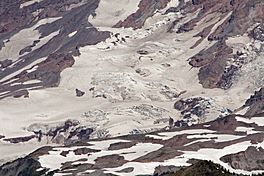Wilson Glacier (Mount Rainier) facts for kids
Quick facts for kids Wilson Glacier |
|
|---|---|
 |
|
| Type | Mountain glacier |
| Location | Mount Rainier, Pierce County, Washington, USA |
| Coordinates | 46°49′19″N 121°45′09″W / 46.82194°N 121.75250°W |
| Area | 0.5 square miles (1.3 km2), 1983 |
The Wilson Glacier is a medium-sized glacier found on the southeast side of Mount Rainier. Mount Rainier is a large volcano in Washington, USA. This glacier is named after A.D. Wilson. He was part of one of the first groups to climb Mount Rainier.
Contents
Wilson Glacier: A Mount Rainier Ice Giant
The Wilson Glacier is an important part of the icy landscape on Mount Rainier. It is one of many glaciers that help shape the mountain. Glaciers are like very slow-moving rivers of ice. They form when snow piles up over many years and turns into ice.
Where is the Wilson Glacier?
The Wilson Glacier is located on the southeast side of Mount Rainier. This mountain is in Pierce County, Washington. The glacier starts high up on the mountain. It then flows downhill towards the south.
How Big is the Wilson Glacier?
The Wilson Glacier covers an area of about 0.5 square miles (1.3 square kilometers). That's roughly the size of 250 football fields! It holds a lot of ice. Scientists estimate its volume is about 1.9 billion cubic feet (54 million cubic meters).
How the Glacier Moves and Melts
The Wilson Glacier begins high up on Mount Rainier. Its highest point, called the head, is around 9,700 feet (2,957 meters) above sea level. From there, it slowly moves downhill.
One part of the Wilson Glacier actually connects with a much larger glacier. This is the Nisqually Glacier, which is right next to it. They meet at an elevation of about 8,000 feet (2,438 meters). Another part of the Wilson Glacier ends on a cliff. This cliff is located between the Wilson and Nisqually Glaciers. This part of the glacier ends at about 7,200 feet (2,195 meters).
As the glacier melts, its water forms streams. The meltwater from the Wilson Glacier flows into the Nisqually River. This river then flows down the mountain and eventually reaches the Pacific Ocean.

